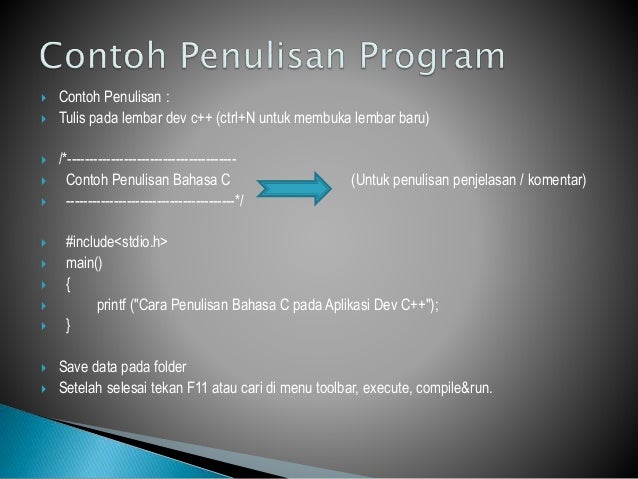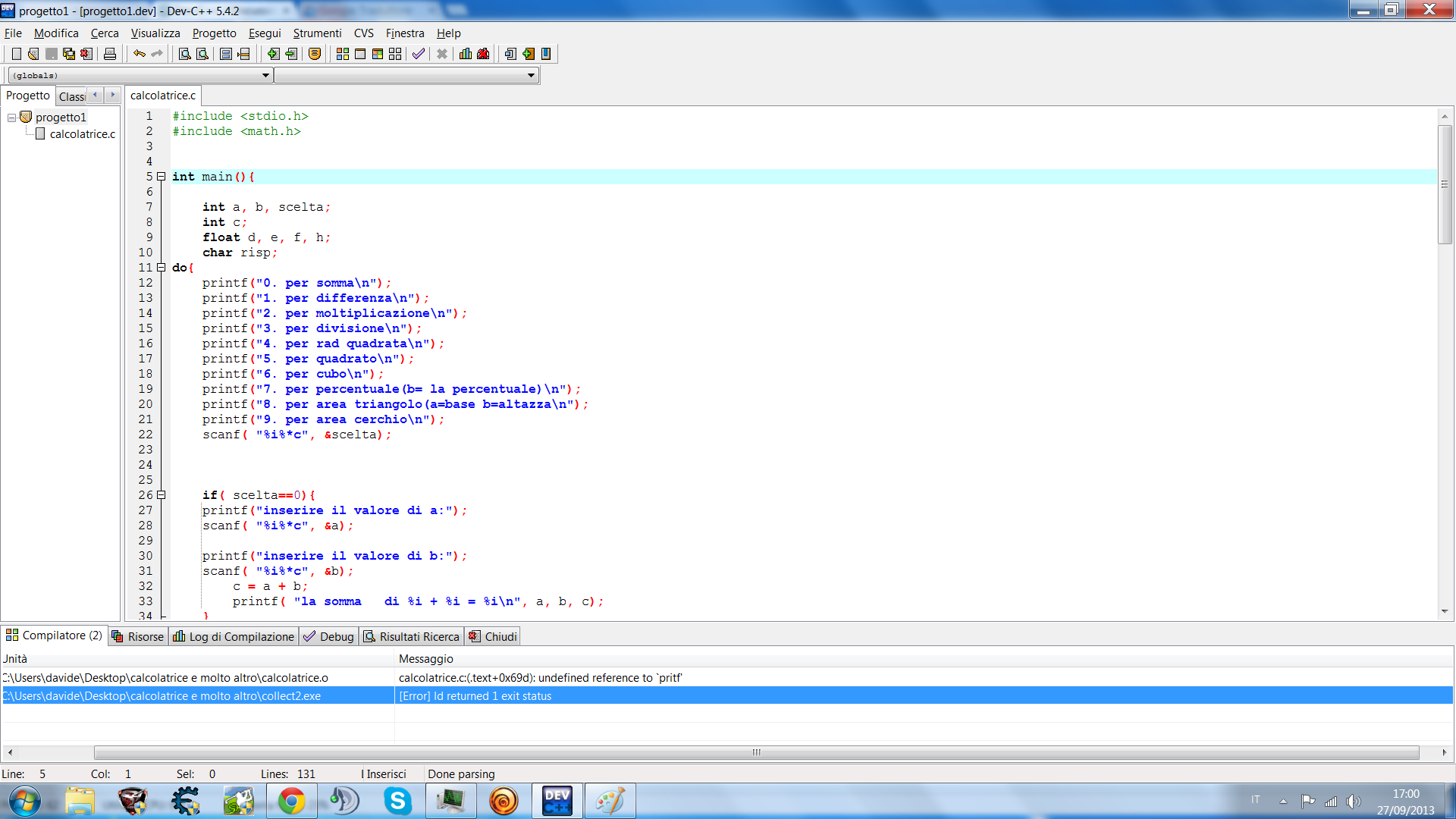Printf Dev C++
- C++ Printf %d
- Funcion Printf Dev C++
- Printf Error In Dev C++
- Printf Decimal
- Printf Decimal Hex
- Printf String Dev C++
The printf function prints output to stdout, according to format and other arguments passed to printf.The string format consists of two types of items - characters that will be printed to the screen, and format commands that define how the other arguments to printf are displayed.
- However, C inherits another form of output from its predecessor, C. This form is based upon a set of functions that are very similar both in appearance and in the way they function. Collectively these functions carry the name of their most widely used member, printf.
- 7 months ago Fernando Echeverrigaray posted a comment on discussion dev-cpp-users. Hi james, how did you do to perform and set the parameters? Or you used CMD of the Windows?
Most examples you see of C++ use the so-called stream output for the code. Stream output uses the << operator, as shown in this example:
However, C++ inherits another form of output from its predecessor, C. This form is based upon a set of functions that are very similar both in appearance and in the way they function. Collectively these functions carry the name of their most widely used member, printf().
You can ignore this article and continue using stream output, or you can switch over to printf() output if you prefer — but you should not mix the two in the same program. These sets of functions use different classes for buffering output to reduce the number of disk accesses, thereby increasing program performance. Mixing the two will cause output to get interleaved in unpredictable ways resulting in confusing and perhaps meaningless output.
The general form of printf() output
The printf() function has the following prototype defined in the cstdio include file:

The ellipses (…) in a prototype declaration means any number of any type of variables.
The first argument to printf() is a string to be output. If this string contains format specifiers, which are characters preceded by a ‘%’, then printf() outputs the next argument in line using that format specifier as guidance.
This is best demonstrated with a simple example:
This would output the string
There must be at least as many arguments following the format string as there are format specifiers in the string. If there are more, they are ignored. printf() returns the number of characters printed. If an error occurs, this number will be negative.
Format specifiers
Format specifiers have the form
Each of these format specifiers is described in the following sections.
Type specifiers
The following type specifiers are available to printf()
| Type Specifier | Type | Example |
|---|---|---|
| d or i | Signed decimal integer | –123 |
| u | Unsigned decimal integer | 456 |
| o | Unsigned octal | 05670 |
| x | Unsigned hexadecimal (lowercase) | 89abc |
| X | Unsigned hexadecimal (uppercase) | 89ABC |
| f, F | Decimal floating point | 123.456 |
| e | Scientific notation (lowercase) | 1.23456e+2 |
| E | Scientific notation (uppercase) | 1.23456E+2 |
| g | The shorter of f or e | |
| G | The shorter of F or E | |
| a | Hexadecimal floating point (lowercase) | |
| A | Hexadecimal floating point (uppercase) | |
| c | Character | c |
| s | char* (ASCIIZ string) | example |
| p | Pointer address | bc080 |
| % | The % character | % |
There is at least one type specifier for each of the variable types intrinsic to C++. In the absence of any further information, C++ uses default values. For example, an integer number output with a d is preceded with a – if it is negative but not preceded with anything if it is positive. In addition, such a value takes only as many spaces as are needed to output the number.
Output amplifier flags
What if the default display format for an integer specifier such as d is not what you want? For example, for some applications, it might be important that positive numbers are preceded by a + (plus sign) in the same way that negatives are preceded by a – (minus sign). For that, printf() provides these output amplifier flags.
C++ Printf %d
| Flag | Operating on Type | Has the Following Effect |
|---|---|---|
| – | all | Left justify output. |
| + | numeric | Precedes positive numbers with a +. Negative numbers are always preceded by a -. |
| space | numeric | Insert a blank if no sign is going to be written. |
| # | o, x, or X | Precede number with 0, 0x,or 0X. |
| # | a, A, e, E, f, F, g, G | Include a decimal point even if the fractional part of the number is zero. |
| 0 | number | Left-pad the number with zeroes (useful when printing dollar amounts). |
Funcion Printf Dev C++
Output width flag
Suppose that you want all of the numbers in a column to line up. In that case, it would be important that each number occupy the same number of spaces even if not all of those spaces are needed to display the value. For this and thousands of other applications, printf() allows the user to specify the width by using these width flags.
Printf Error In Dev C++
| Width | Meaning |
|---|---|
| number | The minimum number of characters to allocate for this field. |
| * | The width is specified in an integer argument to printf() preceding the number to be formatted. |
Precision flag
The precision flag is most often combined with the width flag when displaying floating point numbers. In this case, the precision flag tells printf() how many digits to display after the decimal point.
The precision flag has been given meaning for types other than floating point, as shown here, but these are less commonly used.
| Precision | Operating on type | Has the following effect |
|---|---|---|
| number | d, i, o, u, x, X (integer types) | The minimum number of characters to output. Pad on the left with 0’s if necessary. |
| number | a, A, e, E, f, F (floating point types) | The number of digits to print after the decimal point. |
| number | g, G (floating point types) | The maximum number of significant digits to be printed. |
| number | s (character string) | The maximum number of characters to output. |
| blank | all | A period not followed by a number is the same as a precision of 0. |
| * | all | The precision is specified in an integer argument to printf() preceding the number to be formatted. |

Printf Decimal
Length flags
Unlike the flags discussed above, the length flag is not so much about telling printf() how to display the number but more about telling printf() about the number itself. For example, suppose you want to output a variable using a d format, but that variable is actually a long int? No problem, just use ld,as described here.
| Length | d, i | u, o, x, X | decimal | c | s |
|---|---|---|---|---|---|
| none | in | unsigned int | double | int | char* |
| hh | signed char | unsigned char | |||
| h | signed short | unsigned short | |||
| l | long | unsigned long | wchar_t | wchar_t* | |
| ll | long long | unsigned long long | |||
| L | long double |
Printf Decimal Hex
Reviewing the advantages and disadvantages of printf()
The printf() style of output has one significant advantage compared with stream output: the grammar is extremely terse. Once you’ve master all the special types and lengths, widths and precisions, you can output a variable in just about any way you want with a minimum number of keystrokes.
The terseness comes with a price, however:
Printf String Dev C++
The terseness makes printf() output difficult for the uninitiated to understand.
printf() is not type safe.
If you say to output the next field using a %Lf, then printf() will assume that a long double is waiting there. It has no way to double check. If a simple double or (heaven forbid!) an integer is the next variable on the stack, then printf() will output garbage. Worse yet, it will continue to output garbage from that point forward since now the specifiers and the arguments are out of sync.
printf() is not extensible.
The writers of printf() thought of a lot of different types of variables, but if they didn’t think of it, then you’re out of luck.
|